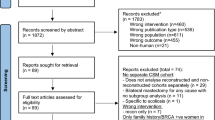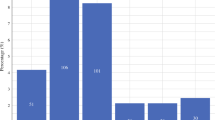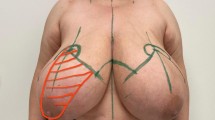Abstract
Background
The Pitanguy method of reduction mammaplasty has been shown to be an anatomically safe technique in the management of the ptotic breast. However, the technique, as first described, cannot be applied in gigantomastia or severe breast ptosis cases or cases of dense parenchyma of the breast. The senior surgeon suggested an intraoperative modification of the Pitanguy method of reduction mammaplasty to make it applicable for such cases.
Methods
A retrospective study of 122 patients with severe breast ptosis (70), gigantomastia (45), or dense breast parenchyma (7) who underwent a modification of the Pitanguy method was performed. The current procedure involves all the operating steps of the superior pedicle technique as described by Pitanguy, from the marking technique to the keel resection of the breast. If the nipple–areola complex is elevated inadequately, the surgeon can use the senior surgeon’s modification to elevate the complex to the desired height. This modification consists of dissecting the upper pole of the breast vertically to the fascia of the pectoralis major muscle and laterally to the nipple–areola complex. The medial flap is then advanced superiorly, rotated 90°, and sutured to point A, while the lateral flap is placed below the medial one. This maneuver maximizes elevation of the nipple–areola complex to the desired height.
Results
The mean change in nipple position was 14 cm (range = 10–16 cm). The mean weight reduction of each breast was 900 g (range = 700–1300 g). The follow-up included 119 patients and the follow-up period ranged from 1 to 3 years (mean follow-up = 2 years). Three patients were operated on less than 3 months ago and were not involved in this study. All patients gained natural shaped breasts and they were pleased with the results. Serious complications, including flap necrosis, were avoided since caution was used to preserve the internal mammary perforators while performing this method.
Conclusion
This technique provides a versatile, well-vascularized pedicle that allows elevation of the nipple–areola complex at the desired height in cases of severe breast ptosis, gigantomastia, or dense breast parenchyma.




Similar content being viewed by others
References
Georgiade NG, Serafin D, Riefkohl R, Georgiade GS (1979) Is there a reduction mammaplasty for “all seasons?”. Plast Reconstr Surg 63:765–773
Gradinger GP (1988) Reduction mammoplasty utilizing nipple–areola transplantation. Clin Plast Surg 15:641–654
Hawtof DB, Levine M, Kapetansky DI, Pieper D (1989) Complications of reduction mammaplasty: comparison of nipple–areolar graft and pedicle. Ann Plast Surg 23:3–10
Koger KE, Sunde D, Press BH, Hovey LM (1994) Reduction mammaplasty for gigantomastia using inferiorly based pedicle and free nipple transplantation. Ann Plast Surg 33:561–564
Oneal RM, Goldstein JA, Rohrich R, Izenberg PH, Pollock RA (1991) Reduction mammoplasty with free-nipple transplantation: indications and technical refinements. Ann Plast Surg 26:117–121
Palmer JW, Taylor GI (1986) The vascular territories of the anterior chest wall. Br J Plast Surg 39:287–299
Matarasso A, Pitanguy I (1996) The keel resection/Pitanguy reduction mammaplasty. Oper Techn Plast Reconstr Surg 3:156–169
Strombeck JO (1960) Mammaplasty: report of a new technique based on the two pedicle procedure. Br J Plast Surg 13:79–90
McKissock PF (1972) Reduction mammaplasty with a vertical dermal flap. Plast Reconstr Surg 49:245–252
Nahai F (2005) The art of aesthetic surgery: principles and techniques. Quality Medical Publishing, St.Louis, MO
Hugo NE, McClellan RM (1979) Reduction mammaplasty with a single superiorly based pedicle. Plast Reconstr Surg 63:230–234
Fox JW (2005) Superior pedicle reduction mammaplasty. Aesthet Surg J 25:406–412
Pitanguy I (1967) Surgical treatment of breast hypertrophy. Br J Plast Surg 20:78–85
Passot R (1931) Correction esthétique de la ptose mammaire. In: Doin G (ed) Chirurgie Esthétique: Technique et Résultats. G. Doin & Co, Paris
Lassus C (1970) A technique for breast reduction. Int Surg 53:69–72
Lejour M (1994) Vertical mammaplasty and liposuction of the breast. Plast Reconstr Surg 94:100–114
Lejour M, Abboud M, Declety A, Kertesz P (1990) Reduction of mammaplasty scars: from a short inframammary scar to a vertical scar. Ann Chir Plast Esthet 35:369–379
Leone MS, Franchelli S, Berrino P, Santi PL (1997) Vertical mammaplasty: a personal approach. Aesthetic Plast Surg 21:356–361
Palumbo SK, Shifren J, Rhee C (1998) Modifications of the Lejour vertical mammaplasty: analysis of results in 100 consecutive patients. Ann Plast Surg 40:354–359
Cárdenas-Camarena L, Vergara R (2001) Reduction mammaplasty with superior-lateral dermoglandular pedicle: another alternative. Plast Reconstr Surg 107:693–699
Abramson DL, Pap S, Shifteh S, Glasberg SB (2005) Improving long-term breast shape with the medial pedicle wise pattern breast reduction. Plast Reconstr Surg 115:1937–1943
Landau AG, Hudson DA (2008) Choosing the superomedial pedicle for reduction mammaplasty in gigantomastia. Plast Reconstr Surg 121:735–739
Disclosures
The authors have no conflicts of interest or financial ties to disclose.
Author information
Authors and Affiliations
Corresponding author
Rights and permissions
About this article
Cite this article
Foustanos, A., Panagiotopoulos, K. & Skouras, G. Intraoperative Modification of Pitanguy Technique of Reduction Mammaplasty for Elevation of the Nipple–Areola Complex in Case of Severe Breast Ptosis. Aesth Plast Surg 35, 55–60 (2011). https://doi.org/10.1007/s00266-010-9556-0
Received:
Accepted:
Published:
Issue Date:
DOI: https://doi.org/10.1007/s00266-010-9556-0




